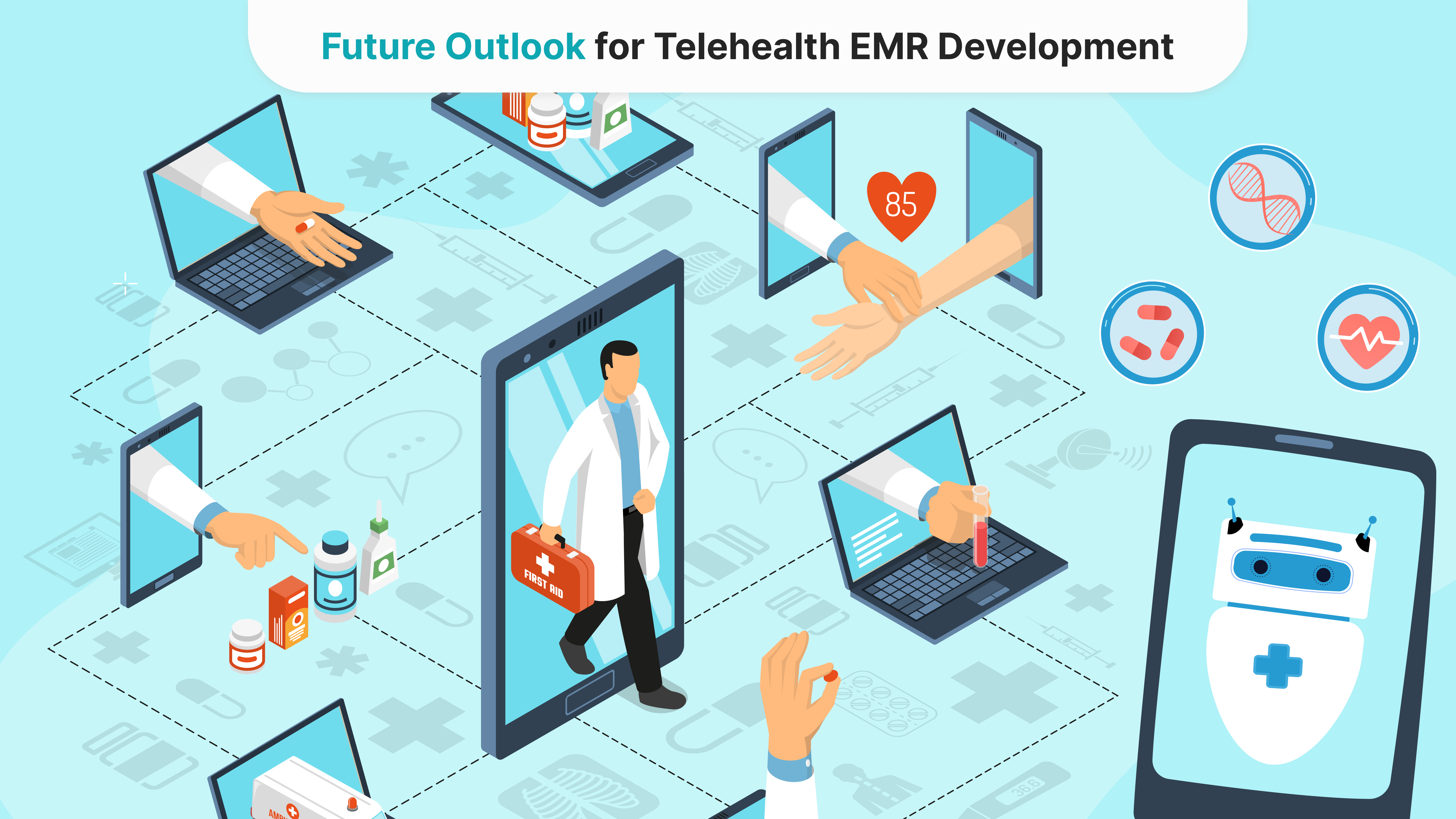

The Present and Future of Telehealth EMR Development
Telehealth has emerged as a transformative force in healthcare delivery, offering increased access to care, improved patient outcomes, and reduced costs. Electronic Medical Records (EMRs) play a crucial role in this evolution, enabling seamless integration of telehealth services into existing healthcare systems. This article explores the present landscape of telehealth EMR development, examining the challenges, opportunities, and latest trends shaping its future.
Current State of Telehealth EMR Development
The integration of telehealth within EMR systems has witnessed significant advancements in recent years. EMR systems now incorporate virtual encounters seamlessly, allowing patients to schedule appointments, participate in video consultations, and receive medical advice from the comfort of their homes. This integration has extended to mobile platforms, enabling patients to access their health records, schedule appointments, and engage in virtual visits through dedicated mobile applications.
Next-generation tools and technologies are driving the evolution of telehealth, extending the telemedicine model to include cell phones and internet-based telecommunications tools for remote and home health management. These advancements incorporate video assessment, remote bedside monitoring, and patient-specific care tools with event logs, patient electronic profiles, and physician note-writing capabilities.
The COVID-19 pandemic significantly accelerated the demand for and development of telehealth solutions. It prompted regulatory changes and increased reimbursement for telehealth services, leading to a focus on coherence, security, and remote patient monitoring capabilities within EMR systems. While previously telehealth was restricted to specific locations and providers, with limitations on reimbursement rates, the CARES Act and CMS 1135 Waiver expanded telehealth access. This allowed any clinician to bill for Medicare services, regardless of location or pre-existing patient relationships.
Challenges in Telehealth EMR Development
Despite the progress, several challenges hinder the development and adoption of telehealth EMRs.
Challenge | Description | Example |
Interoperability | Difficulty exchanging information between different EMR systems. | A patient with diabetes and heart disease sees multiple specialists. Their records are spread across different EMR systems, making it difficult for providers to get a complete picture of their health and coordinate care effectively. |
Security and Privacy | Ensuring confidentiality and integrity of patient data. | A data breach exposes sensitive patient information, leading to privacy violations and potential legal consequences. |
User Resistance | Overcoming resistance to change and adopting new technologies. | Some healthcare providers may be hesitant to adopt telehealth EMRs due to unfamiliarity with the technology or concerns about workflow disruptions. |
Training Needs | Providing adequate training to healthcare professionals and patients. | Staff needs to be trained on how to use the new telehealth EMR system effectively, including scheduling virtual appointments, conducting video consultations, and managing patient data. |
Cost | Managing the cost of implementation and maintenance. | A small rural clinic may struggle to afford the initial investment and ongoing costs associated with implementing a telehealth EMR system. |
Lack of Comprehensive Physical Examination | Limitations in conducting a thorough physical exam remotely. | A patient with abdominal pain may require an in-person examination to diagnose the cause accurately. |
Data Security Concerns | Risks associated with transmitting and storing patient data electronically. | Hackers gain access to a telehealth platform, compromising patient data and potentially disrupting services. |
High Infrastructure Costs | The need for reliable internet access and appropriate devices. | Patients in remote areas with limited internet connectivity may face challenges accessing telehealth services. |
Opportunities in Telehealth EMR Development
The challenges in telehealth EMR development also present significant opportunities for innovation and improvement.
Opportunity | Description | Example |
Standardized Platforms | Developing platforms that integrate telehealth data into EMR systems. | A platform that allows data from remote patient monitoring devices to be automatically uploaded and integrated into a patient’s EMR, enabling real-time monitoring and timely interventions. |
Streamlined Operations | Automating tasks and improving efficiency. | A telehealth EMR system that automatically sends appointment reminders to patients, reducing no-shows and improving clinic efficiency. |
Improved Decision-Making | Enhancing data availability for informed medical decisions. | A telehealth platform that integrates with a patient’s EMR, providing clinicians with a comprehensive view of their medical history, lab results, and medication lists during a virtual consultation. |
Revenue Growth | Expanding access to care and reducing overhead costs. | A rural hospital implements a telehealth EMR system, enabling them to provide care to patients in remote areas, increasing their patient base and revenue streams. |
Future Outlook for Telehealth EMR Development

The future of telehealth EMR development appears promising. Key trends shaping the future include:
Seamless Integration with EHRs: Telehealth EMRs will be designed to integrate seamlessly with existing EHR systems, ensuring continuity of care and facilitating data exchange between different platforms.
AI-Powered Solutions: AI will continue to play a crucial role in telehealth EMR development, enabling more personalized, efficient, and accessible healthcare solutions.
Focus on User Experience: Improving digital health literacy and making telehealth solutions easier to use will be crucial as more people rely on telehealth tools.
Personalized Telemedicine Solutions: In 2025, developing personalized telemedicine solutions will be key to improving healthcare access and patient outcomes. Tailored apps will enable medical professionals to deliver care that meets the unique requirements of their patients.
Architecture of Big Data and Telehealth Integration: The future of telehealth EMR development will heavily rely on integrating big data. This involves collecting information from various sources, such as EHRs, wearable devices, medical imaging, and lab results, and storing it securely in cloud-based data storage solutions. Data processing and analytics will then be used to transform this raw data into actionable insights, which can be displayed on data visualization dashboards to help clinicians make informed decisions and monitor clinical outcomes.
Evolving Regulatory Landscape: The regulatory landscape for telehealth is constantly evolving, and developers need to stay informed about changes in regulations and compliance requirements.
Regulatory Landscape for Telehealth EMR Development
The regulatory landscape for telehealth EMR development is complex and constantly evolving. Key considerations include:
HIPAA Compliance: Telehealth EMRs must comply with the Health Insurance Portability and Accountability Act (HIPAA), ensuring the privacy and security of patient health information.
State and Federal Regulations: Telehealth providers must navigate a complex web of state and federal regulations, including licensing requirements, prescribing regulations, and privacy laws.
Data Security and Privacy: Protecting patient data from unauthorized access and breaches is crucial. Telehealth EMR developers must implement robust security measures to ensure data integrity and confidentiality.
Interstate Medical Licensure: Regulations regarding interstate medical licensure can impact telehealth providers’ ability to deliver care across state lines. To address this, the Interstate Medical Licensure Compact has standardized licensing requirements, allowing physicians to practice in multiple states and provide remote digitalized services.
Telehealth Parity Laws: Telehealth parity laws in many states require commercial health insurers to provide equal coverage for telehealth and in-person services, promoting wider adoption of telehealth.
HIPAA Flexibility During COVID-19: The COVID-19 pandemic led to a temporary relaxation of some HIPAA rules, allowing for greater flexibility in the use of telehealth technologies. This highlights the evolving nature of regulations and their impact on telehealth adoption.
Global Recommendations for Telehealth Regulations: On a global scale, countries are encouraged to develop regulatory frameworks, programs, plans, guides, manuals, guidelines, and best practices in telemedicine. These should be aligned with short-, medium-, and long-term objectives outlined in roadmaps and inspired by principles that support digital transformation processes in healthcare.
Conclusion
Telehealth EMR development is revolutionizing healthcare delivery, offering increased access to care, improved patient outcomes, and reduced costs. While challenges remain, the opportunities for innovation and improvement are significant. By embracing the latest trends and technologies, such as AI, IoMT, and big data analytics, developers can create telehealth solutions that are more personalized, efficient, and accessible.
Faq
What is the current state of telehealth EMR development?
+Telehealth EMR development is rapidly advancing, with a focus on integrating AI-powered platforms that combine virtual nursing capabilities and ambient sensing technologies to create intelligent care environments. These systems are evolving beyond basic telemedicine into sophisticated remote presence systems, enabling specialists to extend their expertise across geographic boundaries and improve care access in rural communities.
How are electronic medical records (EMR) being integrated into telehealth services?
+Modern telehealth platforms now offer seamless EMR integration, allowing healthcare providers to access and update patient information, including medical history, lab results, and treatment plans, in real-time during virtual consultations. This integration enhances the quality and continuity of care by streamlining workflows, enabling e-prescriptions, and ensuring secure data exchange across the healthcare ecosystem.
What role does healthcare technology play in telehealth EMR development?
+Healthcare technology plays a pivotal role in telehealth EMR development by integrating AI-powered platforms, advanced sensors, and computer vision to create intelligent care environments that enhance patient monitoring and clinical decision-making. These technologies are transforming patient rooms into smart spaces that continuously monitor vital signs and environmental conditions, while also enabling the evolution of virtual care platforms that extend specialist expertise across geographic boundaries, improving care access and catalyzing new hybrid care models.
How is patient data managed and secured in telehealth EMR systems?
+Patient data in telehealth EMR systems is managed and secured through advanced encryption techniques, multi-factor authentication, and secure cloud storage solutions. Modern EHRs employ stringent security measures like data encryption, which converts patient information into coded formats accessible only to authorized users, while multi-factor authentication adds an extra layer of protection by requiring multiple verification steps for system access. Additionally, secure cloud storage provides a virtual, guarded environment for patient records, ensuring data is protected from physical threats and accessible to healthcare providers as needed, all while maintaining compliance with HIPAA regulations.
Tell us about your project
Fill out the form or contact us

Tell us about your project
Thank you
Your submission is received and we will contact you soon
Follow us
